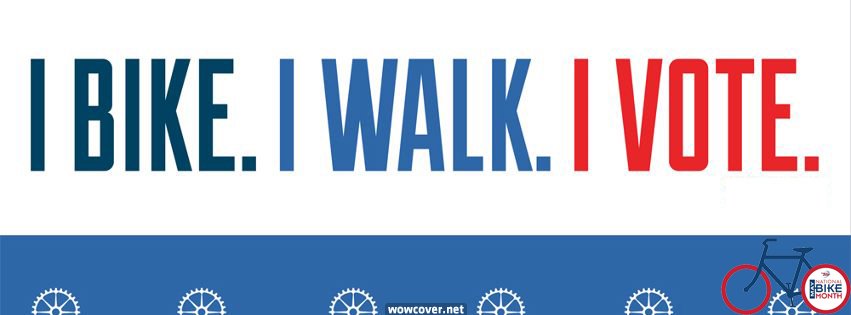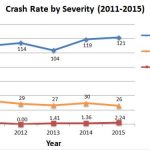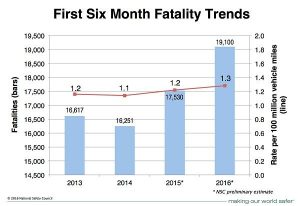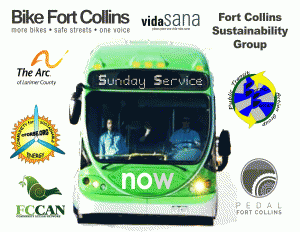
 I first got directly involved with Bike Fort Collins a little over a year ago, when, after a series of senseless, heartbreaking deaths of Northern Colorado cyclists on local roads, BFC reached out to me to help lead an emergency bike safety town hall. In attendance were council members, traffic engineers, county road engineers, state patrol, the sheriff’s office, state senators and over 200 concerned bike riders of all backgrounds. It was heartening to see so many people, especially influential civic leaders, empowered to make changes and taking this challenge seriously.
I first got directly involved with Bike Fort Collins a little over a year ago, when, after a series of senseless, heartbreaking deaths of Northern Colorado cyclists on local roads, BFC reached out to me to help lead an emergency bike safety town hall. In attendance were council members, traffic engineers, county road engineers, state patrol, the sheriff’s office, state senators and over 200 concerned bike riders of all backgrounds. It was heartening to see so many people, especially influential civic leaders, empowered to make changes and taking this challenge seriously.
Subsequently, I came aboard to lead BFC and make sure that we followed through on the promise of that town hall. That we continued to rally every stakeholder in NoCo to prioritize what I called at the time a public health and safety crisis.
From my first day, I was honored to be entrusted with a chance to lead this critical charge. And from my first day, I knew that sooner or later, the day would come when I would find myself arranging a vigil ride and ghost bike dedication for another Northern Colorado cyclist.
September 20th, 2016

Jason Holden
Berthoud resident Jason Holden was descending CR 8E near Carter Lake when it appears he was clipped by a passing SUV. It knocked him off of his bike and into oncoming traffic. He was struck and killed by a driver who stopped and called the police. The SUV left the scene and is still being sought by investigators.
On October 1st, with Jason’s friends and family, Bike Fort Collins organized another vigil, and another ghost bike dedication, for another cyclist killed on Larimer County roads.
Two weeks removed from this tragedy, there are still more questions than answers. But what we do know sounds disturbingly familiar.

Jason Holden Ghost Bike Dedication, October 1 CR 8E near Carter Lake
Like Steve Studt, Ernesto Weidenbrug, and Cesar Palermo, Jason Holden appears to have been riding within his legal rights.
Like Ernesto Weidenbrug, the driver fled the scene, leaving Jason to die. Ernesto’s killer did eventually turn herself in, while Jason’s killer hasn’t been found as of this writing.
Like Steve Studt, Jason was killed by a driver who tried to pass under unsafe circumstances. Studt’s killer passed on a bridge with inadequate visibility. When an oncoming car came into view, the driver swerved back into Studt’s lane, knocking him off of his bike and running him over. Jason’s killer passed him on a fast narrow downhill stretch.
Knowing that stretch well, it seems likely to me that Jason was traveling at or near the speed limit. Knowing that he was a skilled, experienced cyclist, it’s likely he was positioned defensively in the lane, to keep a driver from trying to unsafely squeeze past him. Apparently, it wasn’t enough.
Is it alarmist to call traffic violence a crisis?
I don’t think so. Nationally, 35,000 people were killed in traffic violence in 2015 (a 7.2 percent increase). Projections for 2016 are significantly worse.
For comparison, the national murder rate was 15,000 in 2015 (the lowest rate since 1966).
According to Larimer County’s own traffic safety reports, our roads see twice as many annual fatalities as the state and national averages. And according to the Larimer County Coroner’s Office, 2015 saw 39 traffic related fatalities (one quarter of all accidental deaths), compared to 7 homicides.
This disparity leads to a statistic that some people will find shocking: Rural Americans are considerably more likely to die a violent death than urbanites.
Indeed, in our misguided fear of urban crime and pollution, too many Americans have gravitated towards very low density rural communities, which require tremendous infrastructure, generate tremendous pollution, and exact a very heavy toll on public health and safety. As a result, too much of our public spending goes into subsidizing and preserving comfort and convenience for an already resource-intensive cohort. And safety and mobility for ALL people in Larimer County takes a backseat to speed and efficiency of automobile drivers.
Now What?
It should be clear then that the challenge here, that the real obstacle to safer, healthier streets and neighborhoods, is bigger than helmets and bike lanes. We, all of us, need to admit that traffic violence is a singular threat to health and safety in Northern Colorado. Token education campaigns and better signage and pointing fingers at impaired or distracted drivers or rude cyclists isn’t going to turn the tides without a top to bottom appreciation of our collective accountability for this crisis, and our role in solving it. This is a crisis that deserves a reappraisal of our budget and policy priorities, not just for transportation, but for land use and zoning, public health, development and law enforcement priorities and training. This is a crisis that demands we ask: how can we expect drivers to respect vulnerable users when our roads don’t?
In Larimer County
There are many questions about what needs to change at the city, county and state levels. Bike Fort Collins has our priorities. We want to hear yours, and we want to hear from our elected leaders too. Over the next month, between now and election day, we need your help. What transportation, safety, development, law enforcement, and infrastructure related questions do you want to pose to candidates for the Larimer County Board of Commissioners? Click HERE to add your questions to our list.
If you live in Fort Collins, there is still time to engage with your city council member on the importance of supporting budget offers that promote sustainable transportation. Bike Fort Collins is asking council to fund 3 offers that are currently in danger of not being funded:
67:11 – Sunday Transfort Service would help Fort Collins keep pace with peer cities in providing year round, affordable mobility to all residents.
3.12 – FC Walks would create a staff position in the city transportation planning department to promote programs and planning that encourages and enables pedestrian access and safety.
3.22 FC Bikes Enhancement would allow FC Bikes to continue to offer its current lever of programming as some grant funding expires. Among FC Bikes great programs are Bike to Work Day, the Bike Ambassador Program, Open Streets, Bike Friendly Driver program and more. In Fort Collins, bike crash numbers have dropped over the past two years, FC Bikes great programming and education clearly contributes to that trend an deserves ongoing support.
If you’d like to ask your council member to support these offers, write them by November 1 at cityleaders@fcgov.com (be sure to include your street address) and let them know you support sustainable transportation.
In Loveland
- Add more bike racks and designated bike parking throughout town
- Add a recreational path along BNSF, as identified in the bike and pedestrian master plan
- Add more wayfinding throughout town (along recreational paths, to downtown, to identify popular and safe bike routes)
- Widen and improve N. Boyd Lake, as identified in the bike and pedestrian master plan
- Link downtown through a connection at Fairgrounds Park
- Add a connection from the north side of town into downtown
- A dedicated staff member for implementation and coordination of bike and pedestrian infrastructure and projects within the City of Loveland, such as a bike and pedestrian coordinator
- Find your City Council member here by typing in your address, hitting “Submit”, and then clicking “Create Report”.
- Create an email using the language (in red) between the asterisks above and anything else you would like to add. Click here for additional information and resources.
- Send it to your City Councilmember!
If you need further assistance, contact Kelly Haworth.
In Closing
Growth and affordability concerns make the future of Northern Colorado uncertain. We have a spectrum of outcomes. On one hand is a compounding of sprawl and its attendant health and safety threats, along with congestion and pollution and consumption of natural areas and resources and social segregation.
On the other hand we have an opportunity to change the way we plan and build communities and cities and regions that put people first, that build complete streets, that use land responsibly, that invest in shared and sustainable mobility to curb our costly and deadly dependence on private automobiles. In short, we can build a region whose form and policies and governance prioritize safety and community over speed and convenience, and where that commitment sets an example to guide our growth.
If you’ve read this far, I imagine its because you agree that something has to change. That, like me, you’re looking forward to putting ghost bikes and vigil rides behind us. I don’t think we can honestly say that as a region, we’re on that course. But together, with one voice, we can demand that change.
Lets start now.
Executive Director
Bike Fort Collins



